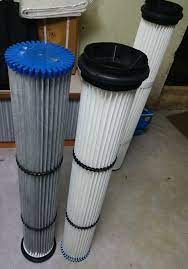Get In Touch
Get In Touch




A top dust collector, also known as a top filter or overhead dust collector, is a specialized industrial air filtration system designed to capture and remove airborne dust, particulates, and contaminants from the environment. Typically installed on the ceiling or elevated platforms, these units employ a network of high-efficiency filters or cartridge filters to extract dust and pollutants from the air. Equipped with powerful fans, they create negative pressure, drawing contaminated air through the filters, allowing clean air to be recirculated. Top dust collectors are widely used in manufacturing, woodworking, metalworking, and various processes, maintaining air quality and ensuring worker health and safety.
1. Airflow Capacity: The airflow capacity is typically
measured in cubic feet per minute (CFM) or cubic meters per hour (CMH) and
represents the volume of air the dust collector can process.
1. Metalworking: Top dust collectors are employed in metal fabrication and machining operations to capture metal shavings, dust, and fumes generated during cutting, grinding, and welding processes.
2. Woodworking: In woodworking shops, these units help control wood dust and particles created by sawing, planing, and sanding, safeguarding worker health and preventing fire hazards.
3. Textile and Garment Industry: Dust collectors manage lint and textile fibers produced during textile manufacturing, garment cutting, and sewing processes.
4. Pharmaceutical Manufacturing: They are used in pharmaceutical facilities to capture and control dust and powders produced during drug formulation, granulation, and tablet pressing.
5. Food Processing: In food and beverage production, top dust collectors manage flour, sugar, spices, and other food-related dust and particles generated during processing and packaging.
6. Chemical and Petrochemical Plants: These collectors control potentially hazardous chemical powders and fumes in chemical manufacturing and storage facilities.
7. Mining and Mineral Processing: They help manage dust and particles generated during the extraction, crushing, and processing of ores and minerals.
8. Foundries: Dust collectors are used in foundries to capture metal dust and fumes from metal casting, melting, and molding processes.
9. Cement and Construction: They control dust and particulates generated during the handling and processing of cement, concrete, and construction materials.
10. Automotive Industry: In auto manufacturing, dust collectors capture and remove dust and particulates generated during painting, welding, and grinding processes.
11. Electronics and Semiconductor Manufacturing: They manage dust and particles produced in the production of microelectronics, ensuring the integrity of sensitive components.
12. Aerospace Industry: Dust collectors are used in aerospace manufacturing to control dust and contaminants during composite material production and machining.
13. Chemical Laboratories: In research and testing labs, these collectors capture and contain hazardous chemical dust and particles.
14. Rubber and Plastic Manufacturing: They manage dust and particulates produced during the processing of rubber and plastic materials, including extrusion and molding.


